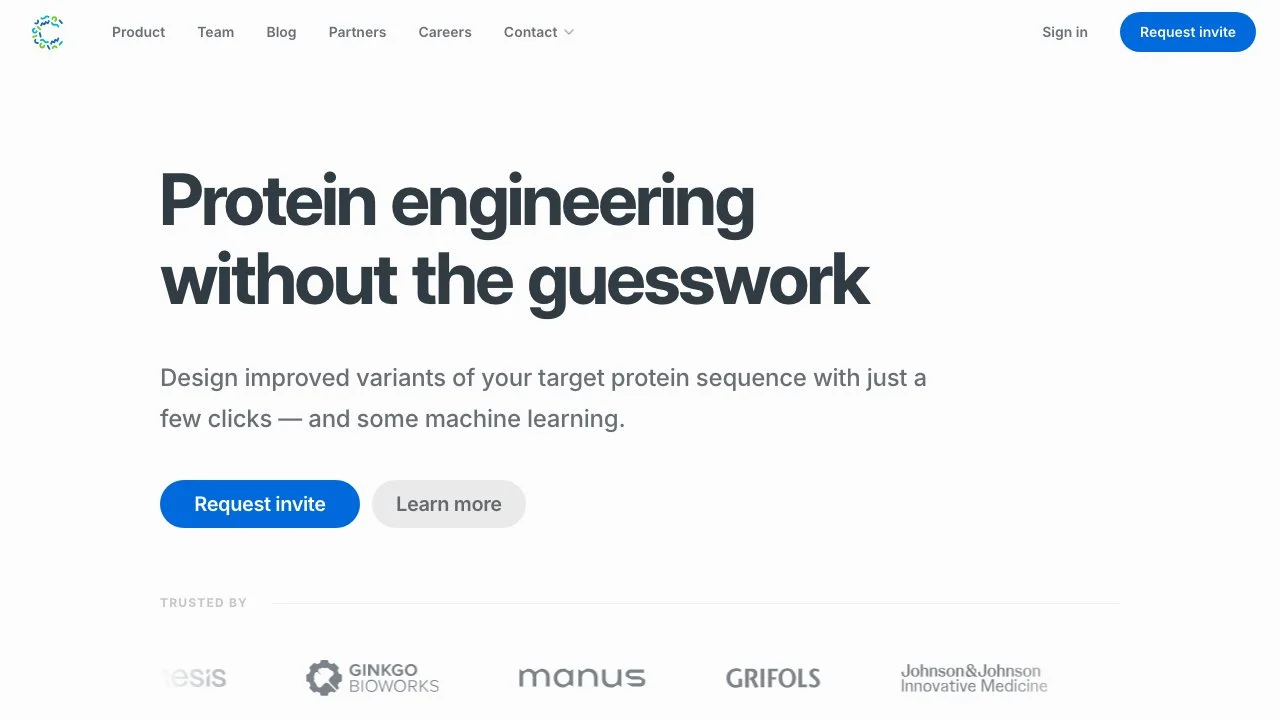Cradle is a revolutionary AI-powered tool for protein engineering. With just a few clicks and the aid of machine learning, it enables the design of improved variants of target protein sequences. Users can start fresh or import assay data from an ongoing project. Each generated sequence comes with a predicted performance score, ensuring more productive lab work. Cradle learns with every experimental round, significantly cutting the time-to-market. It allows for the optimization of multiple properties simultaneously, a feature that sets it apart from traditional methods. Industry leaders and biotech teams are already using Cradle to accelerate their projects. The tool is designed to be user-friendly, fitting seamlessly into existing workflows. Users simply need to specify what they plan to measure and where the measurements should go for a successful project. Generation of improved sequences is a breeze with a simple click, and the tool provides a forecast of expected performance per property. After generation, the new variants can be tested in the lab, and with each round, Cradle gets better with the imported experimental data. This not only improves the private Cradle model but also provides insights for the next round. Moreover, Cradle ensures the privacy and security of users' sequences and data, giving them full ownership of all intellectual property. It uses bank-grade security to keep the data safe. The team behind Cradle believes in the potential of biology and is changing the game in protein design with their tools and machine learning models. The tool is backed by leading investors and has a team of experts and advisors from various fields.

Cradle
Cradle simplifies protein engineering with AI. Design better proteins, optimize properties, and accelerate projects.

Top Alternatives to Cradle
SRI
SRI is an AI-powered R&D institute with diverse offerings
Atomic AI
Atomic AI is an AI-powered RNA drug discovery platform
Immunai
Immunai supports drug discovery with AI-powered solutions
EvoLogics
EvoLogics offers underwater communication and positioning solutions
Bethge Lab
Bethge Lab is an AI research group with diverse focuses
Receptive AI
Receptive AI enhances workplace inclusivity and psychological safety, boosting employee retention.
Galactica Demo
Galactica Demo is an AI-powered research tool designed for the scientific community to explore and reproduce AI research findings.
Quilter
Quilter is an AI-powered PCB designer that automates circuit board layout, optimizing designs for performance and manufacturing.
Labelbox
Labelbox is an AI-powered data labeling platform that helps users build better AI products remarkably fast.
Taalas
Taalas is an AI-powered platform that transforms AI models into custom silicon for 1000x efficiency.
Nextml
Nextml specializes in custom machine learning projects, enhancing satellite image analysis, railroad infrastructure damage detection, and text recognition in industrial settings.
Data Science & AI Workbench
Data Science & AI Workbench is a comprehensive platform that accelerates AI project development and deployment with robust security and governance.
Lambda | GPU Compute for AI
Lambda provides on-demand NVIDIA GPU instances and clusters for AI training and inference, designed for developers.
Granica AI
Granica AI enhances AI projects by optimizing data management for compactness, safety, and efficiency.
Azure Machine Learning
Azure Machine Learning is an enterprise-grade AI service that supports the end-to-end machine learning lifecycle, enabling businesses to build, deploy, and manage ML models at scale.
FlyPix
FlyPix is an AI-powered geospatial platform that helps users detect and analyze objects on Earth’s surface with precision.
Human or AI Game
Human or AI Game is an interactive platform that challenges users to distinguish between human and AI-generated images, contributing to academic research.
KBY
KBY-AI offers advanced SDKs for identity verification, including face recognition, liveness detection, and palm recognition, enhancing security and user experience.
VortiX
VortiX is an AI-powered search engine that helps users find precise scientific research papers with clear explanations.
Rayyan
Rayyan is an AI-powered platform that accelerates systematic and literature reviews, saving researchers significant time.
BioRaptor
BioRaptor is an AI-powered platform that helps scientists extract actionable insights from bioprocess data to enhance product development.